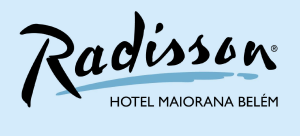O festival Gawai Dayak é celebrado anualmente no dia 1º de junho em Sarawak, é um festival religioso e social. Gawaj significa ritual ou festival e Dayak é um nome coletivo para as tribos de Iban, Bidayuh, Kayan, Kenyah, Kelabit, Murut e muito mais. Traçando suas origens de volta para 1957, o festival Gawai Dayak foi oficialmente publicado em 25 de setembro de 1964 como um feriado público no lugar do Dia de Sarawak. Sendo a primeira celebração oficial em 1º de junho de 1965, Gawai Dayak tornou-se um símbolo de unidade, aspiração e esperança para a comunidade de Dayak e é parte integrante da vida social de Dayak hoje. Os preparativos para o festival começam cedo com a fabricação de tuak (vinho de arroz) e iguarias tradicionais como penganan (bolos de farinha de arroz, açúcar e leite de coco). Na véspera de Gawai, o arroz glutinoso é assado em bambu, conhecido como ngelulun pulut.
A celebração começa na noite de 31 de maio com uma cerimônia chamada Muai Antu Rua (para afastar o espírito de ganância), significando a não interferência do espírito de má sorte nas celebrações. Duas crianças ou homens cada um arrastando um chapan (cesto de peneirar) passarão pelo quarto de cada família no longhouse de Iban com cada família jogando artigos indesejados na cesta. Os artigos indesejados são então jogados no chão a partir do final do longhouse para o espírito de má sorte. Por volta das 18h, a cerimônia de oferecimento conhecida como miring ocorrerá, com música ritual; rayah gendang sendo realizado de antemão. O chefe da festa agradecerá aos deuses pela boa colheita, pedir orientação, bênçãos e vida longa enquanto sacrifica um galo. O jantar será servido, enquanto todos conversam e se misturam à meia-noite. Ao toque da meia-noite, soa um gongo e o tuai rumah levará todos a beber o Ai Pengayu (tuak por longa vida) ao mesmo tempo desejando um ao outro "vida longa, saúde e prosperidade" (gayu-guru, gerai Nyamai). Uma procissão para receber os espíritos conhecidos como Ngalu Petara segue com uma procissão subindo e descendo toda a longhouse. A celebração agora fica mais alegre com a dança e a música tradicional sendo tocadas. Outros irão recitar pantun (poesia).
e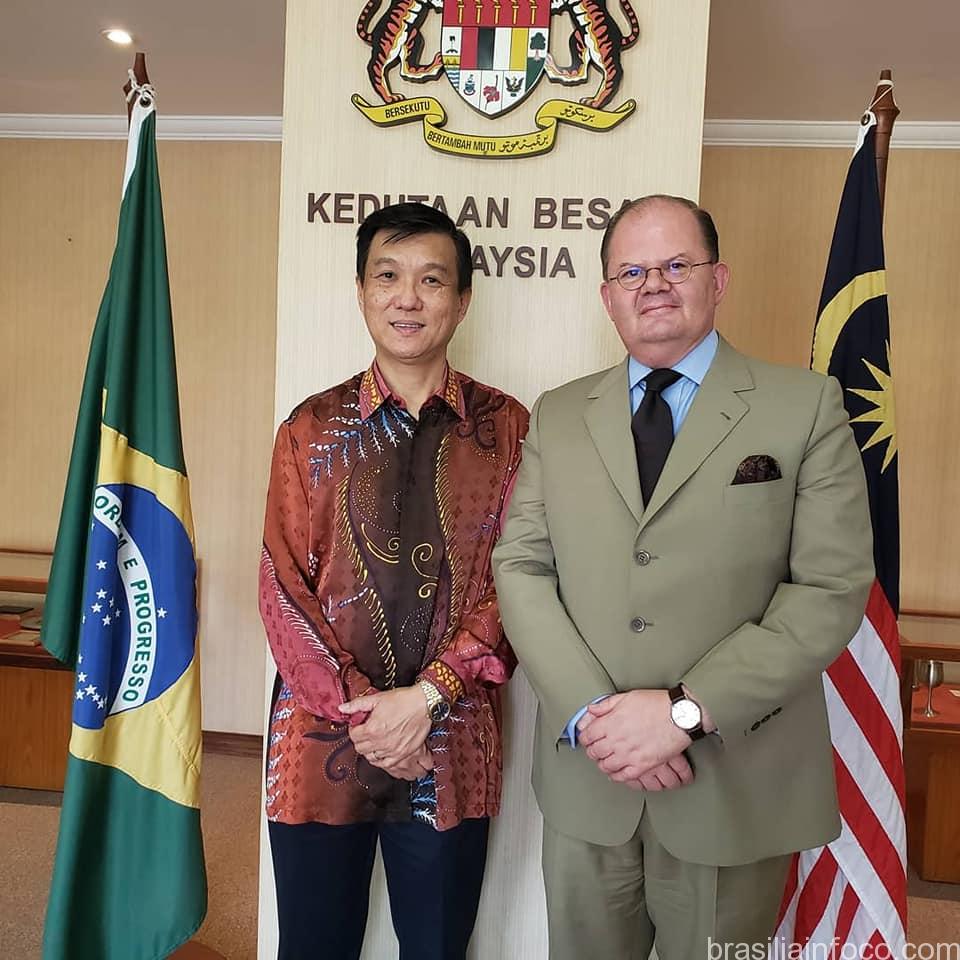
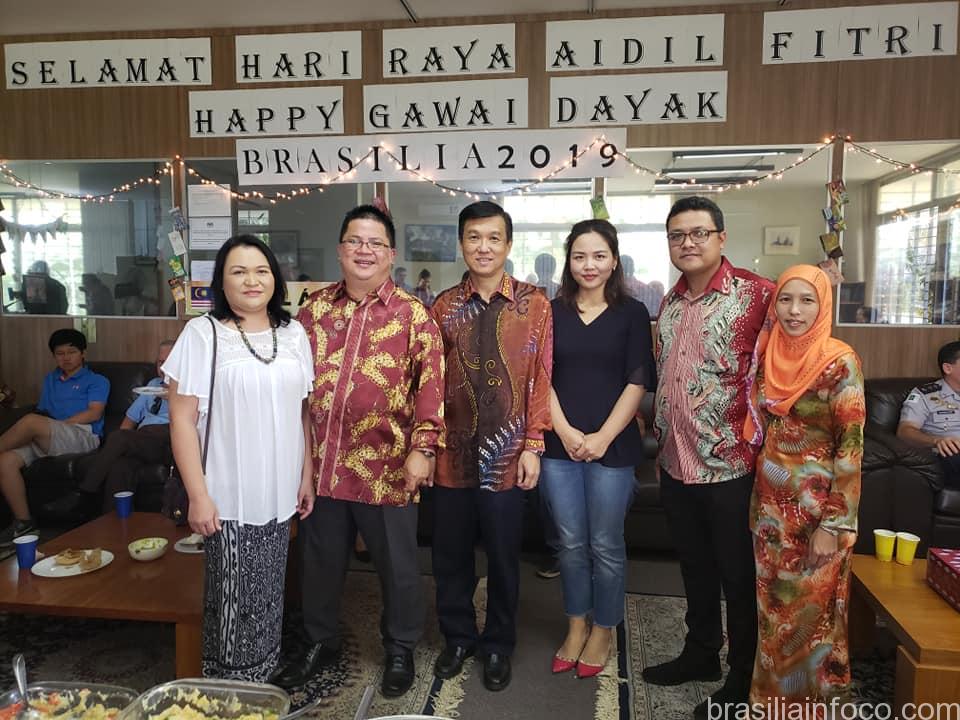
Outras atividades que podem acontecer no dia seguinte incluem combates de galos, demonstrações de maçaricos e competições ngajat (dança). Neste dia, as casas dos Dayaks estarão abertas aos visitantes. Nos longhouses, uma prática chamada masu pengabang ocorre onde os convidados serão servidos com tuak pelo anfitrião antes que eles possam entrar no longhouse. O festival Gawai Dayak pode durar vários dias, com os visitantes sendo recebidos nas casas dos Dayaks durante todo o festival. É também nessa época do ano que acontecem muitos casamentos de Dayak, pois é raro que todos os membros da comunidade se reúnam na casa de uma vez. Na cidade capital de Sarauch, Kuching, as festividades e celebrações do Gawai Dayak começam uma semana antes, com encantadoras paradas de rua e atividades culturais. Na véspera do Gawai, um concurso de beleza é realizado coroando várias Gawai Queens, uma para cada comunidade de Iban, Bidayuh e Orang Ulu. Alguns lugares notáveis para visitar durante o festival Gawai Dayak são o rio Skrang, o rio Lemanak, Batang Ai e Annah Rais. Gawai Dayak é uma das melhores épocas para visitar Sarawak, pois as festividades são abundantes e o estilo de vida ganha vida, abraçando os visitantes nas celebrações
Como a Malásia celebra Hari Raya Aidilfitri?
6 de julho de 2016 Hari Raya Aidilfitri, o festival da quebra do jejum, um feriado religioso celebrado pelos muçulmanos na Malásia. Hari Raya significa "dia de celebração", e Hari Raya Aidilfitri é o dia que marca o fim do Ramadã, o mês sagrado islâmico do jejum do amanhecer ao pôr-do-sol. Hari Raya Aidilfitri cai em 6 de julho e 7 de julho deste ano. O que acontece no dia de Hari Raya Aidilfitri? Os muçulmanos acordam cedo para visitar a mesquita para agradecer a Deus pelas bênçãos que têm na vida. Eles buscarão perdão e receberão pacotes "verdes" de dinheiro dos mais velhos. Enquanto vestidas com suas melhores roupas, eles farão uma visita a parentes, familiares e amigos para se deliciar com comida tradicional e deliciosa; Ketupat (bolo de arroz), Lemang (arroz glutinoso) e muitos outros alimentos tradicionais. Quais são as roupas tradicionais usadas no dia? As mulheres geralmente usam Baju Kurung, Baju Kebaya ou Jubah. Enquanto isso, os homens usam a versão masculina de um Baju Kurung junto com um Kain Samping - um pedaço de pano usado sobre as calças do Baju Kurung. É comum ver homens usando um songkok em suas cabeças também. Você tem que trazer algum presente? A maioria dos muçulmanos na Malásia não espera que os convidados apresentem presentes ou dinheiro. Se os convidados insistirem em apresentar algo, então doces, biscoitos ou kuih serão melhores e serão apreciados pela maioria dos anfitriões. Os hóspedes também devem procurar o que não oferecer. O preto é uma cor evitável. Vinho, champanhe ou qualquer outra forma de álcool é proibido para os muçulmanos.
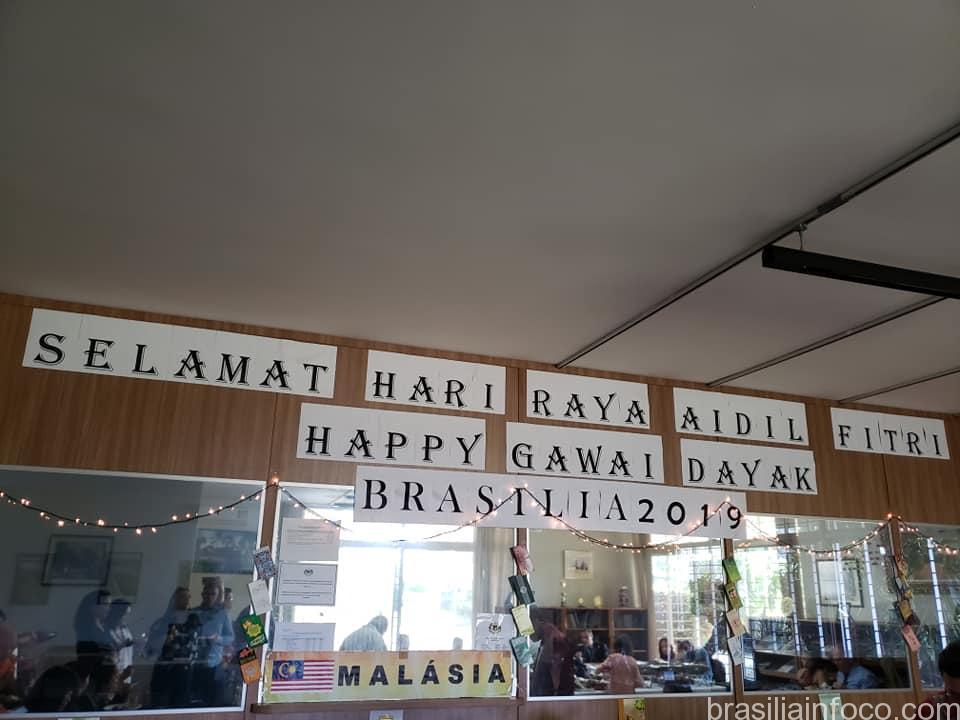
The Gawai Dayak festival is celebrated yearly on 1 June in Sarawak, is both a religious and social festival. Gawaj means ritual or festival and Dayak is a collective name for the tribes of Iban, Bidayuh, Kayan, Kenyah, Kelabit, Murut and more. Tracing its roots back to as early as 1957, the Gawai Dayak festival was formally gazetted on 25 September, 1964 as a public holiday in place of Sarawak Day. The first official celebration being on 1 June, 1965, Gawai Dayak became a symbol of unity, aspiration and hope for the Dayak community and is an integral part of Dayak social life today. Preparations for the festival begin early with brewing of tuak (rice wine) and traditional delicacies like penganan (cakes from rice flour, sugar and coconut milk). On Gawai eve, glutinous rice is roasted in bamboo known as ngelulun pulut.
The celebration starts on the evening of 31 May with a ceremony called Muai Antu Rua (to cast away the spirit of greediness), signifying the non-interference of the spirit of bad luck in the celebrations. Two children or men each dragging a chapan (winnowing basket) will pass each family’s room in the Iban longhouse with each family throwing unwanted articles into the basket. The unwanted articles are then tossed to the ground from the end of the longhouse for the spirit of bad luck. Around 6pm, the offering ceremony known as miring will take place, with ritual music; gendang rayah being performed beforehand. The feast chief will thank the gods for the good harvest, ask for guidance, blessings and long life as he sacrifices a cockerel.Dinner will then be served, while everyone talks and mingles awaiting for midnight. At the stroke of midnight, a gong is sounded and the tuai rumah will lead everyone in drinking the Ai Pengayu (tuak for long life) at the same time wishing each other ‘long life, health and prosperity’ (gayu-guru, gerai- nyamai). A procession to welcome the spirits known as Ngalu Petara ensues with a procession walking up and down the entire length of the longhouse. The celebration now gets merrier with dancing and traditional music being played. Others will recite pantun (poetry).
Other activities that may follow the next day include cock-fighting, blowpipe demonstrations and ngajat (dancing) competitions. On this day, the homes of the Dayaks will be open to visitors. In the longhouses, a practice called masu pengabang takes place where guests will be served with tuak by the host before they can enter the longhouse. The Gawai Dayak festival may last up to several days, with visitors being welcomed to the homes of the Dayaks throughout the festival. It is also this time of year that many Dayak weddings take place, as it is rare for all members of the community to assemble at the longhouse at one time. In Sarawak’s capital city of Kuching, the festivities and celebrations of the Gawai Dayak commence even a week before with enchanting street parades and cultural activities. On the eve of the Gawai, a beauty pageant is held crowning several Gawai Queens, one for each Iban, Bidayuh and Orang Ulu communities. Some notable places to visit during the Gawai Dayak festival are The Skrang River, The Lemanak River, Batang Ai and Annah Rais. Gawai Dayak is one of the best times to visit Sarawak as the festivities are aplenty and the lifestyle comes alive, embracing visitors within the celebrations
How Malaysia celebrates Hari Raya Aidilfitri?
July 6, 2016 Hari Raya Aidilfitri, the festival of the breaking of the fast, a religious holiday celebrated by Muslims in Malaysia. Hari Raya means ‘celebration day’, and Hari Raya Aidilfitri is the day that marks the end of Ramadan, the Islamic holy month of dawn-to-sunset fasting. Hari Raya Aidilfitri falls on July 6 and July 7 this year. What happens on the day of Hari Raya Aidilfitri? Muslims wake up early to visit the mosque to thank God for the blessings they have in life. They will seek for forgiveness and receive ‘green’ packets of money from their elders. While dressed in their new best clothes, they will pay a visit to their relatives, family and friends to dig into traditional delicious food; Ketupat (Rice cake), Lemang (glutinous rice) and many other traditional foods. What are the traditional clothes worn on the day? Women usually either wear a Baju Kurung, Baju Kebaya or Jubah. Meanwhile, Men wear the male version of a Baju Kurung together with a Kain Samping – a piece of cloth worn over the trouser of the Baju Kurung. It is common to see men wear a songkok on their heads as well. Do you have to bring any gifts? Most Muslims in Malaysia do not expect guests to present gifts or cash. If guests insist on presenting something, then sweets, cookies or kuih are best and will be appreciated by most hosts. Guests should also look out for what not to give. Wine, champagne or any other form of alcohol is forbidden for Muslims.
Food- Culinária:
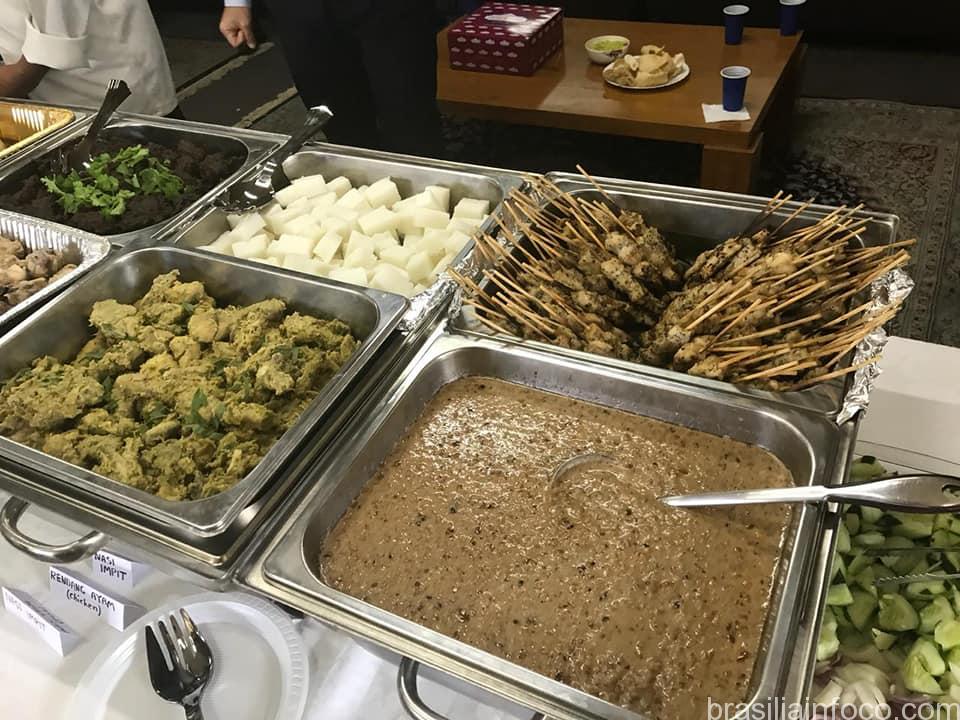
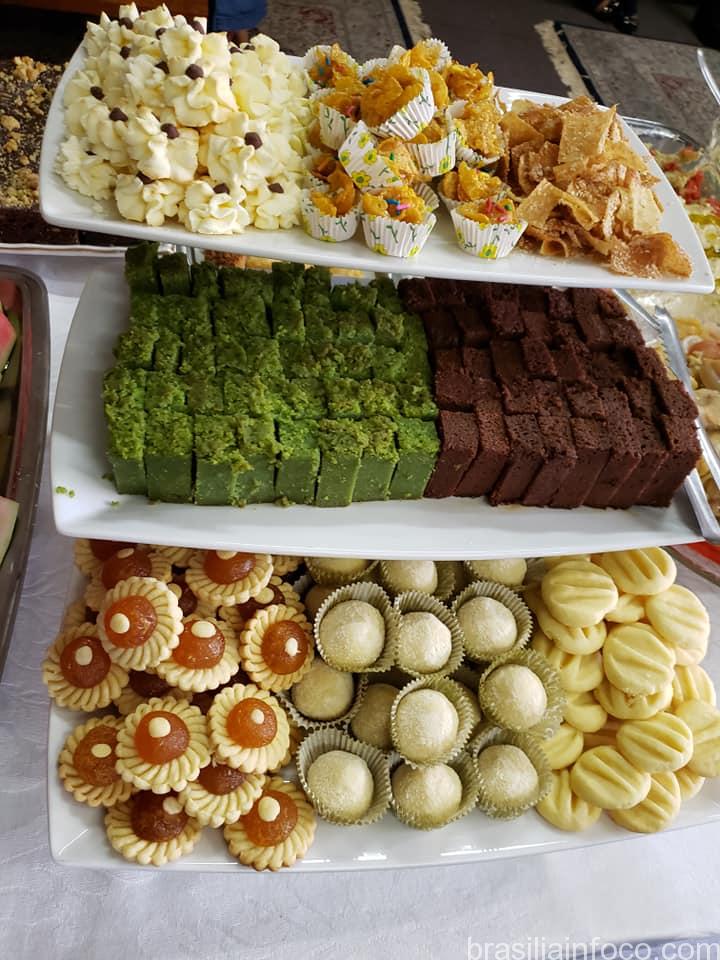
Apoio: Embaixada da Malásia em Brasília




